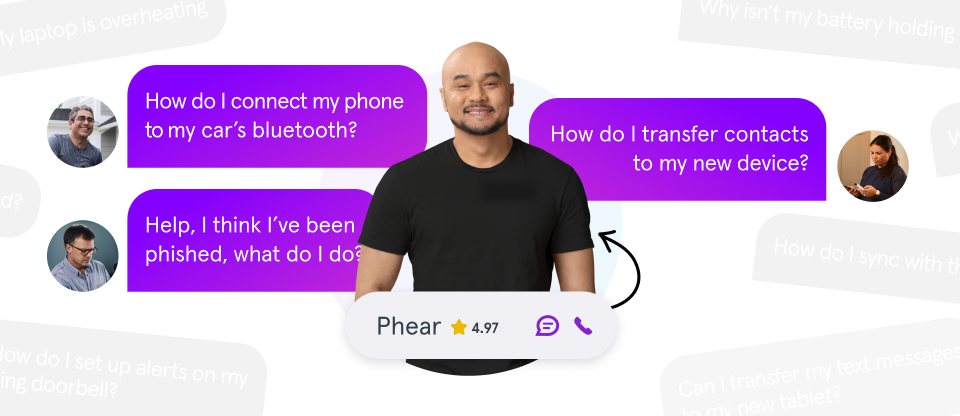Fast fix
If you’re seeing a green or orange dot on your phone screen, it means an app is using your microphone or camera. To check which one:
- iPhone/iPad: Open Control Center—the top will show the app using your mic (orange) or camera (green).
- Android: Swipe down and tap the green light at the top of your screen.
- Windows 11: Look for the microphone icon in the system tray, or check Settings > Privacy & security > Camera/Microphone.
- Alexa/Google Home: Use the privacy settings in the app to mute the mic or review voice history.
It’s happened to most of us: you talk about vacation plans or your favorite TV show, and soon ads related to them pop up on your phone. It makes you wonder, “Is my phone listening to me?”
The truth: apps on your phone, tablet, or computer can use the microphone—and camera—only if you’ve given them permission. Knowing how to check those permissions and update your privacy settings helps you protect your information and take control of your device.
At Asurion, our experts help millions of people understand their tech every day—whether it’s fixing a broken iPhone camera or checking the orange and green dot on iPhone. Here’s how to see which apps are using, or have permission to use, your microphone and camera on iPhone, Android, Windows, Mac, and smart speakers.
Quick privacy settings: iPhone and Android
On iPhone/iPad:
- Go to Settings > Privacy & Security.
- Select Camera or Microphone.
- Toggle off access for apps you don’t trust.
On Android:
- Open Settings > Privacy > Permission Manager.
- Tap Camera or Microphone.
- Adjust each app’s permission to Allow, Ask every time, or Deny.
iPhone, iPad, and Mac
How to check which apps are using your microphone and camera
On iOS® 14 and later, your iPhone or iPad shows colored dots in the top-right corner when your microphone or camera is active:
- Orange dot = an app is using the microphone.
- Green dot = an app is using the camera or both the camera and microphone.
To see which app is responsible:
- Open Control Center.
- On devices with Face ID®, swipe down from the top-right.
- On devices with a Home button, swipe up from the bottom.
- At the top, you’ll see the app using your camera (green) or microphone (orange).
On a Mac, look for the green or orange dots next to the Control Center icon in the menu bar.

Don’t waste time scrolling
Life is short. Ask our experts and get answers now.
How to see which apps recently used your microphone and camera
- iPhone/iPad: Open Control Center—you’ll see whether an app you just closed recently used the mic or camera. On iOS 16, tap the message for full details.
- Mac: Click the Control Center icon and look for the dots with app names.
How to check app permissions and privacy settings
- iPhone/iPad: Go to Settings > Privacy & Security > Camera/Microphone. Toggle access on or off for each app.
- Mac: Go to System Preferences > Privacy & Security > Camera/Microphone. Adjust app access by switching permissions on or off.
Android phones
How to check which apps are using the microphone and camera
On Android 12 and later, a green dot will appear in the top-right corner when your camera or mic is in use. To see the app:
- Swipe down from the top of your screen.
- Tap the green indicator to view the app currently using the feature.
How to manage app permissions and privacy settings
- Open Settings > Privacy > Permission Manager.
- Select Camera or Microphone.
- Choose which apps can access them, and adjust permissions as needed.
Windows 11
How to check which apps are using the microphone and camera
- When an app records audio, a microphone icon appears in the taskbar. Hover over it to see which app is recording.
- If your device has a camera light, it will turn on when in use. If not, Windows will show a notification.
How to see which apps recently accessed them
- Press Win + I to open Settings.
- Go to Privacy & security > App permissions > Camera/Microphone.
- Expand Recent activity to see which apps used them in the last 7 days.
How to check app permissions and privacy settings
- Camera: Go to Settings > Privacy & security > Camera. Make sure Camera access is enabled or disabled for apps you choose.
- Microphone: Go to Settings > Privacy & security > Microphone. Adjust access in the same way.
Smart speakers (Amazon Alexa and Google Home)
Smart speakers are always listening for their wake word—like “Alexa” or “Hey Google”—but you can control when and how they listen by adjusting their privacy settings.
How to manage Alexa microphone settings
- On the speaker itself, press the microphone off button to disable listening.
- In the Alexa app, go to More > Settings > Alexa Privacy > Manage Your Alexa Data.
- Review or delete your voice history.
How to manage Google Home microphone settings
- On your Google Nest or Home device, slide the mic switch to turn the microphone off.
- In the Google Home app, go to Settings > Privacy to manage permissions and activity.
- Review or delete your recordings at myactivity.google.com.
How to tell if your phone is tapped
While the orange and green dots show legitimate app usage, people often ask if their phone is “tapped” or being spied on. Signs may include:
- Unusual battery drain or overheating.
- Data usage spikes you can’t explain.
- Strange background noises on calls.
- Apps you don’t remember installing.
If you suspect unauthorized access, check your app permissions and privacy settings and remove anything unfamiliar.
FAQ
Is my phone really listening to me?
Not constantly—but apps can listen if you’ve given them microphone permission. Ads may also be based on browsing, location, or app activity.
How do I know which app is using my microphone or camera?
Look for the orange/green dots on iPhone and Android, or check Control Center. On Windows, check the microphone icon in the taskbar.
How do I stop apps from using my microphone or camera?
Go to Privacy & Security in Settings (on iPhone, Android, Windows, or Mac) and toggle off permissions for apps you don’t trust.
Is Alexa or Google Home always listening?
Yes, smart speakers listen for their wake word, but you can mute the mic or delete recordings through the Alexa or Google Home apps.
How do I tell if my phone is tapped?
Check for unusual behavior like rapid battery drain, unexplained data spikes, or apps you didn’t install. Review your privacy settings and permissions often.
Tried these steps and still need help? We got you. Get your tech problem solved when you call or chat with an expert now.




